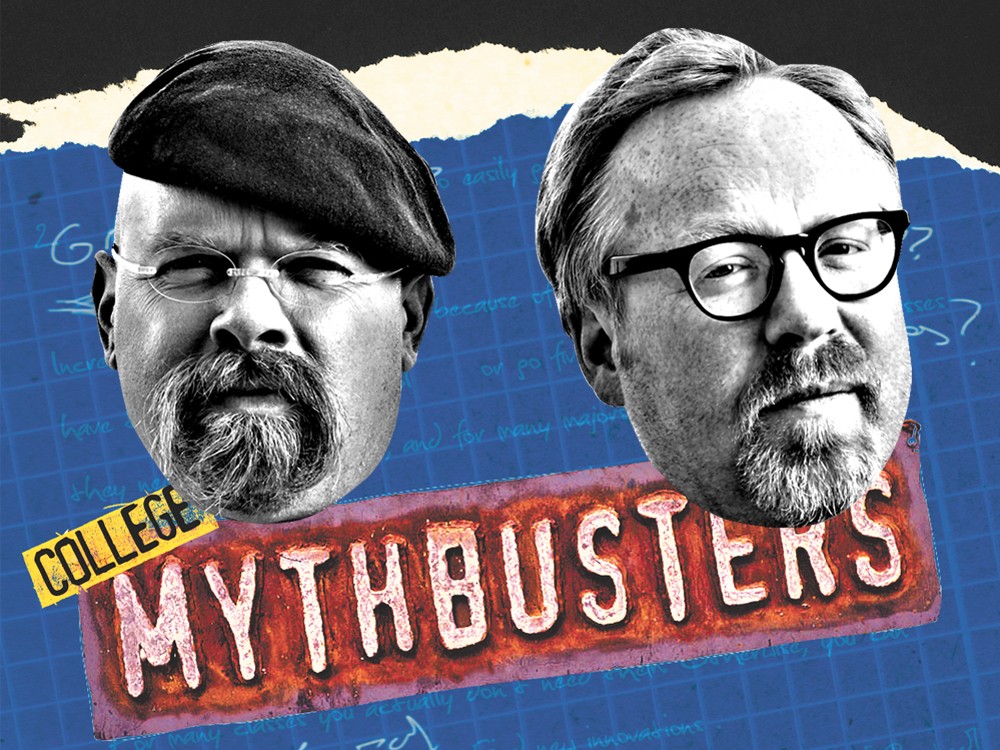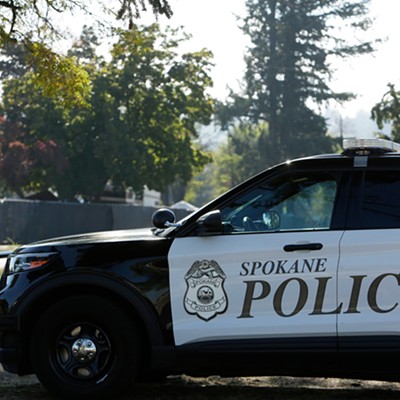Is Gonzaga controlled by a secret society revolving around Bing Crosby’s pipe and Adam Morrison’s mustache? Does a horribly burned professor emeritus really live in the steam tunnels below Whitworth? Did seven students die during a single Eastern Washington University math test? Has the University of Idaho’s president been held hostage by Boise State extremists? Will the Riverpoint campus’s new health building launch a phrenology department? Do Spokane’s community colleges have one of the few remaining sasquatches in captivity?
The answer, to all of these questions, is “No. Don’t be ridiculous.”
But freshmen may have even more questions. The Inlander’s crack team of academic psuedoscientists is here to help. At great expense, and aided by several kilotons of explosives and some witty interoffice banter, we’ve subjected some of the most common college myths to serious scrutiny. Inlander mythbusters have given each myth or legend our stamp of “Busted,” “Confirmed” or “Plausible,” because we understand that’s what they do on the TV show.
Also in this section, we tackle two other complicated questions: How are campuses handling sexual-assault cases? And are for-profit colleges really worth the price?
We fully expect you college students to pull out this packet, carry it around in your Trapper Keeper and read it out loud at parties. Trust us: It’s a surefire path to popularity.
HAZING'S A PART OF CAMPUS LIFE
Excited to join a frat or sports team? Well, pop culture tells incoming students to expect an onslaught of wooden paddles, forced drinking and all sorts of disgusting, horrifying and arcane rituals.
As expected, TV and movies like to exaggerate. Hazing is much rarer and less disgusting. University administrators have tried to stamp out hazing, a misdemeanor offense in both Washington and Idaho. But they admit hazing, defined as initiation that could cause physical or mental harm, still happens.
Last year, a drum major at Florida A&M University was beaten to death in an initiation.
Closer to home, and earlier this year, Washington State University’s Student Conduct Board banned the Pullman campus’s Pi Beta Phi sorority chapter until June 2014 for hazing and underage drinking. Despite that highly publicized local incident, Jami Harrison, assistant director of WSU’s Center of Fraternity and Sorority Life, believes hazing incidents at WSU have significantly decreased in the last decade.
“But we have a ways to go before all students are guaranteed not to experience it,” she says.
Hazing isn’t just typical of college sororities and fraternities. Despite Whitworth University’s lack of a Greek system, Vice President of Student Life Dick Mandeville can name several hazing incidents in the last several years. But he too has seen hazing decline in the last 15 years. Orientation at Whitworth, in other words, should no longer involve being smeared in garbage and motor oil.
Verdict: Plausible Most students won’t be hazed. It isn’t common and it certainly isn’t legal. But a handful of students continue to be victims. They should know that they have the entire legal system set up to defend them.
— CHEY SCOTT
CONSERVATIVE CHRISTIAN UNIVERSITIES ARE BECOMING LESS CONSERVATIVE
In the Inland Northwest, talk about private religious schools like Gonzaga and Whitworth often has more to do with basketball and ultimate Frisbee games than Calvinism versus Arminianism. Could it be that faith is being sidelined?
“Sidelined” is a stretch, but the approach to faith in religious schools has taken a different form. And it’s not a new development. According to Whitworth Dean of Students Dick Mandeville, strict religious requirements such as daily chapel visits were eliminated at the university 40 years ago. Both Gonzaga and Whitworth have Gay-Straight Alliances, multicultural clubs and are allowing plays like the Vagina Monologues. Gonzaga and Whitworth hold no faith requirements for incoming students, but continue to include discussions of faith in a place where it isn’t often found: inside the classroom.
Both Gonzaga and Whitworth want to meld the faith tradition with the academic tradition. At Whitworth, Mandeville says, “We encourage students to ask any question … to be fearless in pursuit of truth.”
As for arguments that religious universities are becoming less conservative, Mandeville says: “The clubs you find at public universities are the same as the ones at private religious universities.” School administrations and donors don’t intend to limit students in their interests.
Verdict: Confirmed Say goodbye to the religious requirements, scripture memorization and bans of yesteryear, and say hello to academic and religious exploration. “The Church has to be open to exploring the question of truth,” says Father Frank Case S.J., Gonzaga’s vice president for mission.
— MARYSSA THOMPSON
YOU'LL NEED TO SPEND A FORTUNE ON BOOKS
At the beginning of each semester, college students everywhere start plotting. Plasma donations go up and musicians busking on corners increase in quantity and desperation.
But don’t sell those kidneys just yet. You may not need to buy books at all. Some profs mistake “suggested reading list” for “required reading list.” Do your research — or even wait a week — before buying. You may get away with borrowing them, sharing with a friend or checking them out from the library.
And if you must buy, please buy responsibly. Textbooks can be found for cheap prices. The smart student avoids the campus bookstore and heads for the Internet. Campusbooks.com allows you to compare prices from multiple sites. Directtextbook.com offers coupons for free shipping. Also check out cheapesttextbooks.com and half.com or even Amazon. Sometimes, you can even find instructor or annotated editions for less than the student ones. Just search for “instructor” or “annotated” along with the rest of the book information.
The next time you log on to Facebook, instead of stalking your ex, take a gander at the underground social media book trade. Most schools have one.
And don’t always fall for the “new edition” nonsense that textbook companies rely on. Contact your professor and ask if edition No. 85 is actually necessary or if edition No. 83 will suffice. Older editions are cheaper and, for the most part, just as useful.
Verdict: Busted A lot of freshmen spend a lot of money on textbooks. But college veterans know how to save.
— SHANNEN KUEST
COMMUNITY COLLEGES ARE FLOODED WITH OLD PEOPLE
So maybe the word “old” is a matter of perspective. If you’re expecting to walk into a nursing home your first day at SCC or SFCC, you may be disappointed.
The reality behind this is that all colleges — both community and four-year — are trying to reach out to more people. Schools are seeking non-traditional students, including adults who have been away from the books for a while.
Between 2000 and 2009, college enrollment among people aged 25 and older increased 43 percent, compared to the 27 percent jump among those younger than 25. At Spokane Community College the average student age is 29 while the average age is nearly 26 at Spokane Falls Community College.
Ken Halverson, 39, can testify to that. Hit hard by the recession, he, like many others his age, came back to school for an opportunity to better his chances at finding a job. “They are accepting a lot more older people,” Halverson says of area colleges, noting his upcoming transfer to the University of Idaho.
Despite his recent accomplishment and the spike in non-traditional student enrollment across the nation, Halverson did have some troubles finding a university that would accept him at his ripe age. “It is opening up, but at the same time it’s not opening up quick enough.”
Verdict: Confirmed Community colleges have always attracted a large number of “non-traditional students,” both young and old. But the recession has sent a new surge of adults — desiring either extra training or student loans to live on while looking for jobs — into the system.
— KARA STERMER
YOU SHOULD BE ABLE TO GRADUATE IN 4 YEARS
Maybe once. But these days, the average college student often doesn’t make it out of school in four years. In fact, more than half take five or six to finish their degree. The question is: Why? The younger generation claims expectations are too high; the older says work ethic is too low. And they’re both right.
Budget cuts are the true enemy to four-year graduation rates. Budget cuts reduce staff, which means universities have to offer fewer courses. This leads to larger classes and longer wait lists, leaving students scrambling for classes as graduation looms. Slashed federal funding also means fewer scholarships, which cause more students to seek employment. It’s no secret that working students frequently take longer to graduate.
Frequent major changes or deciding on a major too late can also really screw up your graduation timeline.
Don’t panic. You can help speed up your degree process by knowing your major from the start and packing your schedule, but sometimes it’s just not possible to get all the classes you need in time.
You have to go into registration with a plan. Prepare multiple possible schedules so when classes fill up and the first one doesn’t work out (and it won’t) you’ll have other options. And take a full credit load every semester. Yes, you might have to actually go to class on Thursdays, but it’ll be worth avoiding the extra year.
Verdict: Busted Due to budget cuts, graduating on time at some colleges takes a combination of work ethic, planning and luck. Many a student has adopted the five-year plan.
— SHANNEN KUEST





















